|
No Sleep Till Sambalpur - or Joshipur, or Chandipur,
or Puri
Orissa
by Sarah Shuckburgh
You can see all of the Indian state of Orissa in a fortnight
but if you like your comfort and hate early starts, don’t
attempt it, says Sarah Shuckburgh
 “You will see everything,” promised Mr Rath at Orissa
Tourism. On a tattered wall-map, he indicated a circular
route from Orissa’s capital, Bhubaneswar, south to Puri and
Gopalpur, west to the tribal region around Jeypore, then
north to Sambalpur, east to Joshipur and back down the coast
via Chandipur and Chandbali. “You will see everything,” promised Mr Rath at Orissa
Tourism. On a tattered wall-map, he indicated a circular
route from Orissa’s capital, Bhubaneswar, south to Puri and
Gopalpur, west to the tribal region around Jeypore, then
north to Sambalpur, east to Joshipur and back down the coast
via Chandipur and Chandbali.
“Two weeks, no problem,” he said, pointing us towards an
ancient Ambassador car, and Babalo, a tall, skinny driver.
Unfortunately, Babalo spoke no English and we spoke no Oryan.
“No problem,” said Mr Rath. “We are buying a dictionary.”
With Mr Rath shouting directions, Babalo drove us through a
chaotic melée of mopeds, rickshaws, buses and cows, past a
jostling festival to the goddess Lakshmi with bare-chested
men in dhotis, and nearly-naked Vishnavite ascetics sitting
cross-legged on the ground. At a bookstall, Mr Rath found a
pirated Oxford English-Oryan dictionary.
 We tried pointing at printed hieroglyphs, but Babalo still
looked blank. Mr Rath was adamant that we didn’t need a
guide, but by the next morning, we’d managed to recruit
Ranjan, who spoke a bit of English, had picked up useful
phrases in several tribal languages while working as a
driver – and knew the way. We set off, all problems
apparently solved. We tried pointing at printed hieroglyphs, but Babalo still
looked blank. Mr Rath was adamant that we didn’t need a
guide, but by the next morning, we’d managed to recruit
Ranjan, who spoke a bit of English, had picked up useful
phrases in several tribal languages while working as a
driver – and knew the way. We set off, all problems
apparently solved.
It didn’t take long to realise that Mr Rath’s itinerary was
too ambitious. Orissa is one of India’s largest states and
one of its poorest. We bumped along dusty, pot-holed roads
for up to 12 hours each day, never lingering at lakes,
temples, waterfalls or wildernesses. By the end we were
exhausted and frazzled.
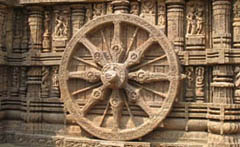 But months have passed, and as we forget the frustrations,
the memories become more vivid – and what memories they are. But months have passed, and as we forget the frustrations,
the memories become more vivid – and what memories they are.
On our first day, we saw enough to fill a week at a more
leisurely pace. After a whistlestop tour of some of
Bhubaneswar’s 500 temples – densely-carved beehive shapes
dating from the 6th century - we drove to Konark and joined
pilgrims at the Sun Temple ruins, gazing at intimate
13th-century wall-carvings, including a thousand sexual
positions to try with one or more partners, or by oneself.
That evening, we reached Puri, seaside home of the Hindu god
Jagannath, whose temple kitchens feed half a million
pilgrims every day. Even at midnight, the seafront heaved
with holidaymakers, cooking on tin braziers, buying trinkets
from hawkers and taking dips, fully dressed, in the warm Bay
of Bengal.
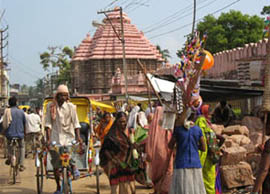 On Day Two, as the overnight train from Calcutta disgorged
more pilgrims, we set off for Chilika lake, Asia’s largest
lagoon and one of the world’s most important wetlands.
Fishermen vied to ferry us to an island-temple dedicated to
a drowned bride whose ghostly voice still sings from the
depths - but Ranjan looked at his watch, and we got back in
the car. We reached Gopalpur at dusk - and were gone by
sunrise. On Day Two, as the overnight train from Calcutta disgorged
more pilgrims, we set off for Chilika lake, Asia’s largest
lagoon and one of the world’s most important wetlands.
Fishermen vied to ferry us to an island-temple dedicated to
a drowned bride whose ghostly voice still sings from the
depths - but Ranjan looked at his watch, and we got back in
the car. We reached Gopalpur at dusk - and were gone by
sunrise.
At night, we stayed in government resthouses – Panthanivas –
poorly run and uniformly spartan and shabby, with peeling
paint and tangles of electric cable. Inside, walls were
stippled with mildew, sleeping bodies sprawled in corridors,
grimy hand-marks smeared kitchen doorways, and filthy towels
hung from hand-washing taps. But the 8am check-out rule was
never inconvenient, as Mr Rath decreed dawn departures.
Each morning, Babalo performed a ritual puja to bless the
car, and draped fresh hibiscus and jasmine on the monkey-god
Hanuman dangling above the dashboard. He and Ranjan drank
curd for breakfast to ensure a safe journey, but also
scoured the verges for auspicious omens, such as a mongoose,
a mynah bird or a jackal on the right of the road. Seeing
unlucky black cats, donkeys, owls, widows or a jackal (on
our left) made them uneasy. Whenever we drove past a temple,
Babalo stopped his incessant hooting and took both hands off
the wheel to pray.
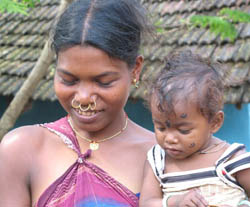 Leaving the coast, we drove through Brahmpur, stifling,
litter-strewn capital of southern Orissa, and climbed into
the cooler rainforest of the Eastern Ghats, pausing briefly
at the temple and hot springs of Taptapani. Women and
children laboured in roadside quarries, breaking stones, and
verges were dotted with broken-down lorries, decorated with
warning sprigs of foliage. Leaving the coast, we drove through Brahmpur, stifling,
litter-strewn capital of southern Orissa, and climbed into
the cooler rainforest of the Eastern Ghats, pausing briefly
at the temple and hot springs of Taptapani. Women and
children laboured in roadside quarries, breaking stones, and
verges were dotted with broken-down lorries, decorated with
warning sprigs of foliage.
 On Day Four, we entered the tribal regions, where, thanks to
Ranjan’s tact and linguistic skills, we were welcomed warmly
by village chiefs. Orissa is home to 62 animist tribes,
materially poor but culturally rich, with traditional music,
dance, craft and costume. Outcastes from Hindu society, they
make up a quarter of Orissa’s population. During the next
few days, Ranjan introduced us to villagers of eight
different tribes, and we smiled at each other with shy
curiosity. We met friendly Poraja women with tattooed faces
and nose rings, their oiled hair fastened with engraved
aluminium hairpins. Dongaria hunter-gatherers, with long
matted ponytails adorned with combs, sat drinking mohua-flower
wine. Shaven-headed Bonda women wore nothing but a narrow
scarf around their hips and dozens of necklaces; their menfolk carried bows and long, sharp arrows. We stooped
under thatched eaves into dark huts in immaculately swept Saura villages, and sat on the decorated mud
verandah On Day Four, we entered the tribal regions, where, thanks to
Ranjan’s tact and linguistic skills, we were welcomed warmly
by village chiefs. Orissa is home to 62 animist tribes,
materially poor but culturally rich, with traditional music,
dance, craft and costume. Outcastes from Hindu society, they
make up a quarter of Orissa’s population. During the next
few days, Ranjan introduced us to villagers of eight
different tribes, and we smiled at each other with shy
curiosity. We met friendly Poraja women with tattooed faces
and nose rings, their oiled hair fastened with engraved
aluminium hairpins. Dongaria hunter-gatherers, with long
matted ponytails adorned with combs, sat drinking mohua-flower
wine. Shaven-headed Bonda women wore nothing but a narrow
scarf around their hips and dozens of necklaces; their menfolk carried bows and long, sharp arrows. We stooped
under thatched eaves into dark huts in immaculately swept Saura villages, and sat on the decorated mud
verandah s of
Gadaba houses. We bought woven palm baskets from Kumhi Khond
women who smoked huge cigars with the lighted end in their
mouths. Children, sometimes naked except for a lucky string
around their waists, accepted our proffered biscuits and
crouched to touch our feet in a traditional gesture of
welcome. s of
Gadaba houses. We bought woven palm baskets from Kumhi Khond
women who smoked huge cigars with the lighted end in their
mouths. Children, sometimes naked except for a lucky string
around their waists, accepted our proffered biscuits and
crouched to touch our feet in a traditional gesture of
welcome.
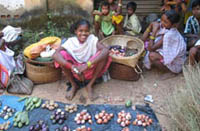 From Jeypore, we drove along misty valleys and through
forests of teak and sal trees to reach distant markets,
where hundreds of tribes-people converged on foot to buy and
sell ginger and turmeric, ten-foot lengths of sugar cane,
deep-fried cakes, plastic bangles, salt, curd, rice wine and
sandals made from lorry tyres. From Jeypore, we drove along misty valleys and through
forests of teak and sal trees to reach distant markets,
where hundreds of tribes-people converged on foot to buy and
sell ginger and turmeric, ten-foot lengths of sugar cane,
deep-fried cakes, plastic bangles, salt, curd, rice wine and
sandals made from lorry tyres.
Lunch was a daily adventure: we stopped at dilapidated
roadside shacks hung with faded posters of flute-playing
Krishna. Rice and dahl, cooked on wood fires, were dolloped
from huge buckets on to rudimentary plates made of sal
leaves pinned t ogether with toothpick-sized bamboo slivers.
We copied Ranjan, washing with a jug of water, and then
eating with our right hands - a lengthy ritual of mashing
and mixing before scooping a fistful into one’s mouth and
flicking lingering morsels to the ground, where crows waited
eagerly. Once we bought two wriggling black crabs and a
dozen 8-inch tiger prawns from a fisherman on a bicycle, and
another day, a live chicken which flapped and squawked in
the car until we reached a roadside kitchen. ogether with toothpick-sized bamboo slivers.
We copied Ranjan, washing with a jug of water, and then
eating with our right hands - a lengthy ritual of mashing
and mixing before scooping a fistful into one’s mouth and
flicking lingering morsels to the ground, where crows waited
eagerly. Once we bought two wriggling black crabs and a
dozen 8-inch tiger prawns from a fisherman on a bicycle, and
another day, a live chicken which flapped and squawked in
the car until we reached a roadside kitchen.
 By Day Nine, we were heading north along roads of dust and
boulders through the monsoon forests which cover almost half
of Orissa, home to tigers, leopards, wolves, bears and
elephants (although we saw none). Sections of tarmac had
been swept away by recent monsoons. Babalo and Ranjan chewed
betel all day, littering the wilderness with a
non-degradable trail of turquoise foil. They opened the car
door every few minutes to spit gory red juice which streaked
the flanks of the white Ambassador. By Day Nine, we were heading north along roads of dust and
boulders through the monsoon forests which cover almost half
of Orissa, home to tigers, leopards, wolves, bears and
elephants (although we saw none). Sections of tarmac had
been swept away by recent monsoons. Babalo and Ranjan chewed
betel all day, littering the wilderness with a
non-degradable trail of turquoise foil. They opened the car
door every few minutes to spit gory red juice which streaked
the flanks of the white Ambassador.
Occasionally we reached an isolated jungle village, where
women drew water at wells, or swept the earth with short
besoms. Scrawny cows and pigs blocked the road as boys
whacked them with sticks and pelted them with stones.
Barefoot men ploughed tiny fields with oxen, or cut rice
with scythes. Nobody spoke English or Hindi, so presumably
few understood hoardings which read “Play cricket with
everyone but have sex with only one”.
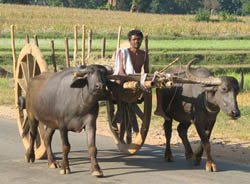
In jostling Sambalpur, Ranjan took us to visit his uncle. We
sat on plastic chairs in a sparsely-furnished concrete room,
sipped tea and ate doughy barfi prepared by his
beautifully-dressed, silent wife. Ranjan explained that
Oryan wives see their husbands as gods, and expect to be
beaten and treated like slaves. During our two-week trip,
Ranjan’s own wife and child were confined to their flat,
forbidden to go out without him.
Oryans dread the birth of girls, who require dowries and
wedding feasts and then are lost to the bridegroom’s family.
Widows have the worst plight - conspicuous, cursed and
polluting. Ranjan admitted that if he glimpsed a white-robed
widow, he would often go home to wash and change. Widows
can’t remarry, but widowers may marry as often as they
choose, and receive an additional dowry with each bride.
‘Kitchen fires’, in which wives burn to death, are common.
 On Day 12, we lurched into Chandipur, a litter-filled
fishing village buzzing with flies. At low tide, the
three-mile beach was dotted with rare horseshoe crabs, a
species unchanged for 200 million years. At Chandbali, we
finally had time to visit a nature reserve of brackish
mangrove creeks swarming with kingfishers, storks,
parakeets, monkeys and giant marine crocodiles. On Day 12, we lurched into Chandipur, a litter-filled
fishing village buzzing with flies. At low tide, the
three-mile beach was dotted with rare horseshoe crabs, a
species unchanged for 200 million years. At Chandbali, we
finally had time to visit a nature reserve of brackish
mangrove creeks swarming with kingfishers, storks,
parakeets, monkeys and giant marine crocodiles.
Nearing the capital, we joined a stretch of
dual-carriageway. Babalo slowed to a nervous crawl, honking
the horn continuously. Bicycles wobbled towards us in the
fast lane, swerving to avoid cows and goats lying in the
sun; tinsel-strewn juggernauts (named after Lord Jagannath)
thundered past us with inches to spare. In the middle of the
road, farmers sat nonchalantly astride buffaloes grazing at
cracks in the tarmac.

Perhaps we should have abandoned Mr Rath’s itinerary and
explored the national parks at Badrama, Debrigarh or
Simlipal, or the waterfalls of Keonjhar. But we were
paralysed by the mind-numbing drives, by the feeling that
what we’d started we must finish, and by Ranjan’s refrain of
“No time for stopping”.
The extreme poverty and the lack of tourist infrastructure
makes Orissa a challenging destination, but Oryans are
open-hearted, unmaterialistic and welcoming, the landscapes
are wild and beautiful, the cultural diversity is rich and
fascinating. Just allow longer than two weeks if you want to
see everything.
First published by the Telegraph
©SarahShuckburgh |